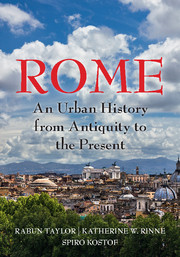Book contents
- Frontmatter
- Dedication
- Epigraph
- Contents
- List of Illustrations
- Acknowledgments
- Map
- INTRODUCTION
- 1 A BEND IN THE RIVER
- 2 A STORYBOOK BEGINNING
- 3 IDEOLOGICAL CROSSFIRE
- 4 BIG MEN ON THE CAMPUS
- 5 RES PUBLICA RESTITUTA
- 6 MEMORIALS IN MOTION: SPECTACLE IN THE CITY
- 7 THE CONCRETE STYLE
- 8 REMAKING ROME'S PUBLIC CORE: I
- 9 REMAKING ROME'S PUBLIC CORE: II
- 10 CRISIS AND CONTINUITY
- 11 RUS IN URBE: A GARDEN CITY
- 12 ADMINISTRATION, INFRASTRUCTURE, AND DISPOSAL OF THE DEAD
- 13 MAPPING, ZONING, AND SEQUESTRATION
- 14 TETRARCHIC AND CONSTANTINIAN ROME
- 15 TROPHIES AND TITULI: CHRISTIAN INFRASTRUCTURE BEFORE CONSTANTINE
- 16 WALLS MAKE CHRISTIANS: FROM FOURTH TO FIFTH CENTURY
- 17 A TALE OF TWO ROMES
- 18 THE ROME OF GOTHS AND BYZANTINES
- 19 CHRISTIAN FOUNDATIONS
- 20 FROM DOMUS LATERANI TO ROMANUM PALATIUM
- 21 THE LEONINE CITY: ST. PETER'S AND THE BORGO
- 22 VIA PAPALIS, THE CHRISTIAN DECUMANUS
- 23 THE URBAN THEATERS OF IMPERIUM AND SPQR
- 24 HOUSING DAILY LIFE
- 25 CHAOS IN THE FORTIFIED CITY
- 26 THE TIBER RIVER
- 27 HUMANIST ROME, ABSOLUTIST ROME (1420–1527)
- 28 PLANNING COUNTER REFORMATION ROME
- 29 PROCESSIONS AND POPULATIONS
- 30 MAGNIFICENT PALACES AND RHETORICAL CHURCHES
- 31 NEOCLASSICAL ROME
- 32 PICTURING ROME
- 33 REVOLUTION AND RISORGIMENTO
- 34 ITALIAN NATIONALISM AND ROMANITÀ
- 35 A CITY TURNED INSIDE OUT
- Glossary of Persons, Places, and Terms
- Works Cited
- Index
9 - REMAKING ROME'S PUBLIC CORE: II
Published online by Cambridge University Press: 05 July 2016
- Frontmatter
- Dedication
- Epigraph
- Contents
- List of Illustrations
- Acknowledgments
- Map
- INTRODUCTION
- 1 A BEND IN THE RIVER
- 2 A STORYBOOK BEGINNING
- 3 IDEOLOGICAL CROSSFIRE
- 4 BIG MEN ON THE CAMPUS
- 5 RES PUBLICA RESTITUTA
- 6 MEMORIALS IN MOTION: SPECTACLE IN THE CITY
- 7 THE CONCRETE STYLE
- 8 REMAKING ROME'S PUBLIC CORE: I
- 9 REMAKING ROME'S PUBLIC CORE: II
- 10 CRISIS AND CONTINUITY
- 11 RUS IN URBE: A GARDEN CITY
- 12 ADMINISTRATION, INFRASTRUCTURE, AND DISPOSAL OF THE DEAD
- 13 MAPPING, ZONING, AND SEQUESTRATION
- 14 TETRARCHIC AND CONSTANTINIAN ROME
- 15 TROPHIES AND TITULI: CHRISTIAN INFRASTRUCTURE BEFORE CONSTANTINE
- 16 WALLS MAKE CHRISTIANS: FROM FOURTH TO FIFTH CENTURY
- 17 A TALE OF TWO ROMES
- 18 THE ROME OF GOTHS AND BYZANTINES
- 19 CHRISTIAN FOUNDATIONS
- 20 FROM DOMUS LATERANI TO ROMANUM PALATIUM
- 21 THE LEONINE CITY: ST. PETER'S AND THE BORGO
- 22 VIA PAPALIS, THE CHRISTIAN DECUMANUS
- 23 THE URBAN THEATERS OF IMPERIUM AND SPQR
- 24 HOUSING DAILY LIFE
- 25 CHAOS IN THE FORTIFIED CITY
- 26 THE TIBER RIVER
- 27 HUMANIST ROME, ABSOLUTIST ROME (1420–1527)
- 28 PLANNING COUNTER REFORMATION ROME
- 29 PROCESSIONS AND POPULATIONS
- 30 MAGNIFICENT PALACES AND RHETORICAL CHURCHES
- 31 NEOCLASSICAL ROME
- 32 PICTURING ROME
- 33 REVOLUTION AND RISORGIMENTO
- 34 ITALIAN NATIONALISM AND ROMANITÀ
- 35 A CITY TURNED INSIDE OUT
- Glossary of Persons, Places, and Terms
- Works Cited
- Index
Summary
THE FIRE OF 80 CUT RIGHT ACROSS THE CITY'S MONUMENTAL CENTER FROM the Palatine Hill westward to the heart of the Campus Martius. The omission of secondary neighborhoods from admittedly sketchy surviving accounts may be merely prejudicial, but we can at least allow that Nero's residential building regulations did some good. Still, the list of high-value architectural casualties is long (Fig. 55). Titus had barely begun repairs before his death in September 81. The city's refashioning would belong to Domitian.
Domitian set about not just repairing or replacing, but augmenting. His architect, Rabirius, devised an entirely new scheme for the residential core of the palace on the southern and eastern Palatine, though we have no evidence that the fire touched this area. In its baroque intricacy and fecundity of volumetric ideas, with its banquet halls, baths, sunken gardens, and elaborate engagement with the Circus Maximus below, the palace became the new beacon of the Roman architectural revolution, outshining the fast-disappearing Domus Aurea (Fig. 56). Obsessively and redundantly, Domitian built monuments to his family: the temple of Vespasian and Titus and the Arch of Titus on the Forum; the Temple of the Flavian Family at his own birthplace on the Quirinal; and the Porticus Divorum, a large enclosure in the Campus Martius on the traditional site where the census was taken and soldiers were conscribed, again honoring his deified father and brother. Following long-standing custom, he was fond of anchoring memorials to events in the urban landscape.
If these dynastic monuments convey insecurity and megalomania in equal measure, Domitian can at least be excused for scrupulously appeasing the gods whose temples had been ravaged in Rome during his lifetime. In the city he dedicated another series of fixtures anchored in the landscape: “altars of the Fire of Nero,” which had been vowed after 64 but never built. The inscription of one altar obliquely chastises Nero's negligence, implying that the fires of 69 and 80 resulted from his impiety. The emperor lavished special attention on Jupiter, whose temple – the Capitolium – had suffered from both calamities.
- Type
- Chapter
- Information
- RomeAn Urban History from Antiquity to the Present, pp. 82 - 92Publisher: Cambridge University PressPrint publication year: 2016



